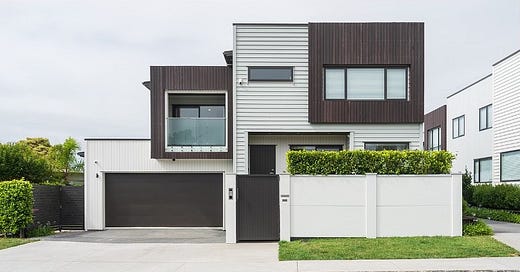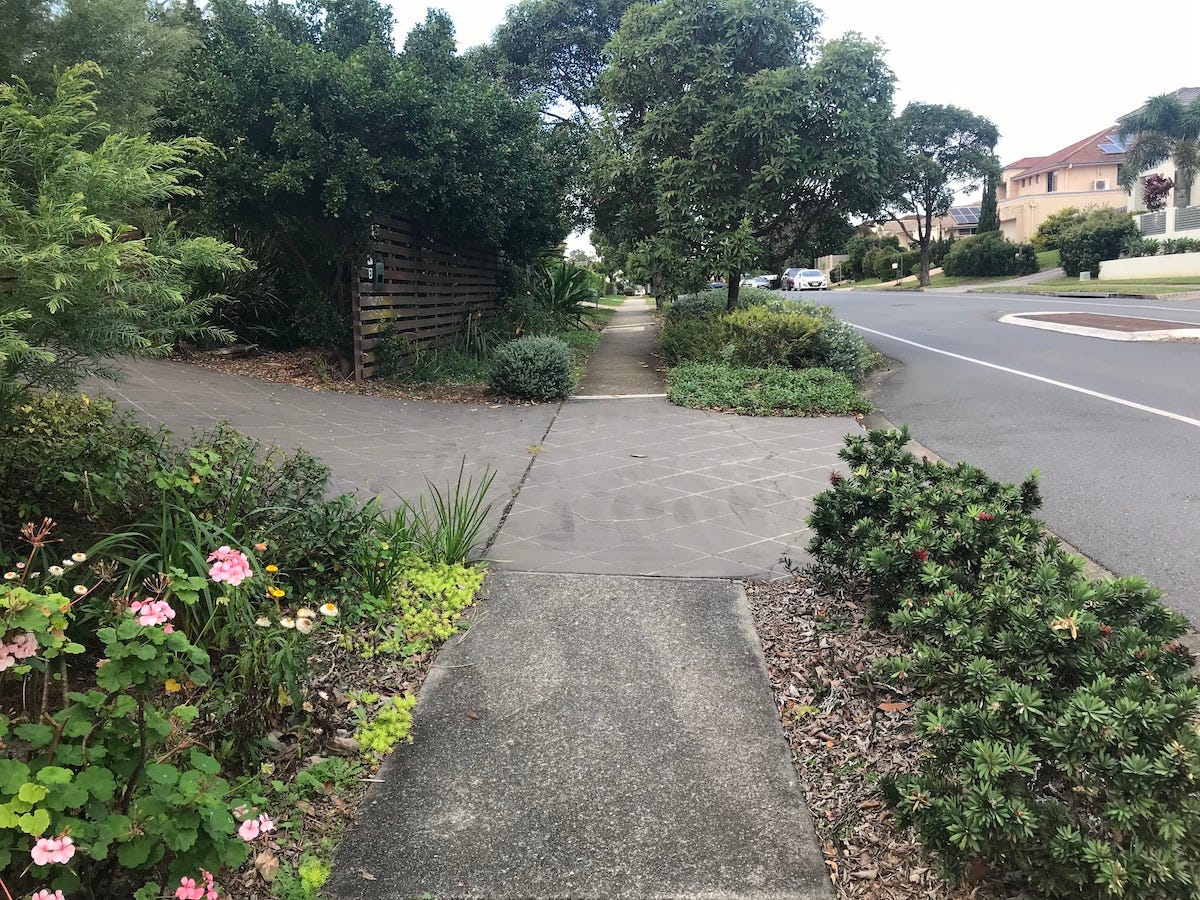Could verge gardens make increased housing density more acceptable?
This article is my contribution to the Regen Brisbane series on housing issues in our region as we grapple with housing affordability, homelessness, and a growing population.
We know that we have to increase urban density and the range of housing options to provide affordable homes for more people within our current urban footprint.
But how do you increase density when so many people resist that change?
Regardless of what planners might recommend, politicians will do what’s politically possible, easy, or advantageous. While greenfield development and low-density suburbs is what is easiest politically, that is what we’ll get, regardless of the environmental and social consequences.
Residents in my suburb campaign tirelessly against townhouses and anything different to the detached house on a suburban block. While those houses get bigger and the blocks get smaller, that expectation of a separation between buildings and the ideal of the Australian backyard, often with a swimming pool, remains strong.
Your House is Your Castle
Looking out from your home to the street, or from the street to your home, the verge is like an apron (or moat!) to your property and not very important in its own right. Your property is what really matters. That’s where you live, where you invest your time and money, and how you show what you’re made of.
Everything you do inside the fence, improving and maintaining your house and garden, is a personal and financial investment for you and your family.
Hopefully, your neighbours will do the same and reinforce the character of your suburb. You don’t want to be the one that lets the street down. And you probably don’t want new homes built that are too different to yours.
A Change of Viewpoint
I often talk about verge gardens and street trees being our long paddock of biodiversity threading through our suburbs. It adds up to a massive amount of land that could be cooling our cities, increasing rainwater infiltration, increasing habitat, and providing many other environmental benefits.
Go out and stand on the footpath in the middle of a verge garden and turn 90 degrees - looking up the street. Walk to the corner, turn and come back, past your home to the next corner, and back again.
The focus here is on the path and the street. This is no longer just a place for cars where we drive to and from our houses. The buildings are not so important now. It makes little difference if they are big, small, detached, terraces, townhouses, or units.
Time and money invested in this public space is an investment in our community. This is not my verge garden, it’s part of the communal pathway that goes past my home. It’s public land, where anyone can wander as they like, perhaps saying hello as they pass or stop for a chat.
It becomes a place for conversations. Some are conversations about the street, what sort of streets we want to live in, what the streets are like now and what they could be.
If you an advocate for change in the design of our cities and transport systems, this is your chance to show how your ideas for change are an improvement on what we have now.
Goodbye to the Backyard
Once we start seeing our streets as places of activity, places for people of all ages to walk and talk and meet and play, and a place where we can all connect with nature, the need for large private gardens diminishes.
A few, like me, will value their private garden and create a biodiverse oasis for wildlife, but many people these days don’t want a large private garden to maintain.
A garden that is all decking and paving and fake grass does nothing for nature and nothing to cool our cities. Neat lawn and hedges for show is not much better, and paying someone to do this high-maintenance, extractive style of gardening is a large expense for homeowners. It’s also a waste of land that could be housing people or regenerating the natural environment.
Transport Alternatives
This change in the way we view our streets opens the discussion on transport and the relative priority given to driving and parking, riding bikes, and walking. If we want people to have fewer, smaller cars in order to address environmental issues, people need to be able to get where they need to go walking, cycling, and on public transport.
More than that, it needs to be a more attractive option to getting in the car. Streets need to be shady and interesting, with paths that are wide enough and safe from trip hazards. Even better, these streets present opportunities for social interaction and getting to know your neighbourhood.
Making Increasing Density Attractive
If we tell people that the design of our cities needs to change, and back it up with lots of facts and arguments about why they ought to accept this change, can we really expect them to say: Oh yes, you’re right, we’ll do exactly that.
We are all emotional creatures, even though some of us kid ourselves that we are very logical. At most, we have learned to moderate our emotional responses with reasoning.
We all have instrinsic values: values that we will go to any length to defend. These can include freedom, independence, autonomy, equity, and safety. We can crave acceptance or validation, a sense of belonging, of status in the eyes of ourselves or others.
But we rarely think or talk about these values.
Instead, we use things to represent our values. This is a process called reification, whereby a house or car become symbols for underlying values. Look at advertisements for cars and you quickly see they are not information about the actual vehicles but instead hook into the values (e.g. freedom, status, autonomy, identity) that potential purchasers might attach to them.
Housing is even more varied, look at the myriad of metaphors we use to describe the places we, and others, live: castle, nest, refuge, den, home, homestead, palace, flat, apartment, slum, dwelling, townhouse, flophouse, cottage, shelter, investment, property, mansion, McMansion, manor, hovel, family home, bachelor pad, lodgings, accommodation, and so on.
When we have these arguments about changing our suburbs, and draw the battlelines between the NIMBY’s and YIMBY’s, it doesn’t always mean that our values clash. It can just be the different things that have come to represent values that we share.
Any surface arguments about changes to urban design and increasing density are underpinned by a swirling mess of competing and unexamined associations with diverse individual values. You might think you are talking about the same thing but one of you is talking about equity and the other is talking about safety. These arguments will lead nowhere, entrenching division. No amount of surface level information and logical reasoning will change that.
Changing the Conversation
It’s easier to be dispassionate and see what’s happening when you aren’t one of the combatants. You’ve nothing at risk, nothing to gain, lose, or defend.
For the people affected, we need to find common ground, not threaten to take away the symbols of their values. This is the work of mediators, storytellers, and innovative change-makers.
If we want people to stop defending something that they value, we need to realise what we are asking of them, and then to offer them a view of something that is at least as good and preferably better to meet that need.
And it has to be show, not tell. Create images that help people imagine what something better might look like. Explore what that better future could be. Both sides might be surprised at the valuable ideas the other parties contribute.
If we cede that ground to advertisers and populist politicians, we won’t achieve any of the changes we need to create a more sustainable world.
This is the stuff of diverse collaboration. It’s not the safe teamwork of like-minds brainstorming. It’s messy and risky and creative. It means dropping the mantle of expert who provides answers and instead embarking on a journey of open curiosity and exploration where everyone brings varying and sometimes unpredictable expertise and ideas to the table.
Forget the Answers: Start with Better Questions
We all have our preferred answers, based on a mix of research and life experiences. But these are wicked problems with many interlinked parts, where there is no one answer.
Questions can open up new and creative ideas and options, pushing for answers close it down.
Let’s take a step back and find questions that we can all agree on to start some more fruitful and exploratory conversations: Something along the lines of:
How could we ensure that everyone in our region has adequate secure shelter with access to work, study, food, and services as part of a sustainable future of our region?
or
How could we ensure that essential workers can live with their families close enough to access their workplaces by affordable public transport?
or
How could we ensure that not being able to fund or drive a private car does not remove the independence and autonomy of people?
What would that future look like?
This post is part of a collaboration with
where several articles from diverse viewpoints are brought together to provide more nuanced conversations about the challenges we face.





I found out today my grandfather almost forgotten how to drive. They had been living within a few hundred metres of EJ station and so they didn’t even own a car. I wasn’t around then but I get the feeling that cars hadn’t become the status accessory they are today. I mention it because we kind of had the answers but somehow something changed.
Super insightful Gayle, especially the part about our intrinsic values and how we each choose to represent them. That definitely made me think.
What are the rights forums to start introducing your fabulous questions so that we can lead politicians, planners, developers, communities and other key stakeholders to have better conversations (and eventually deliver better solutions) when it comes to housing?